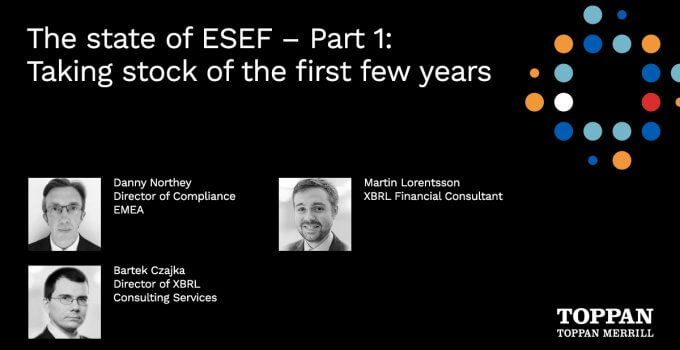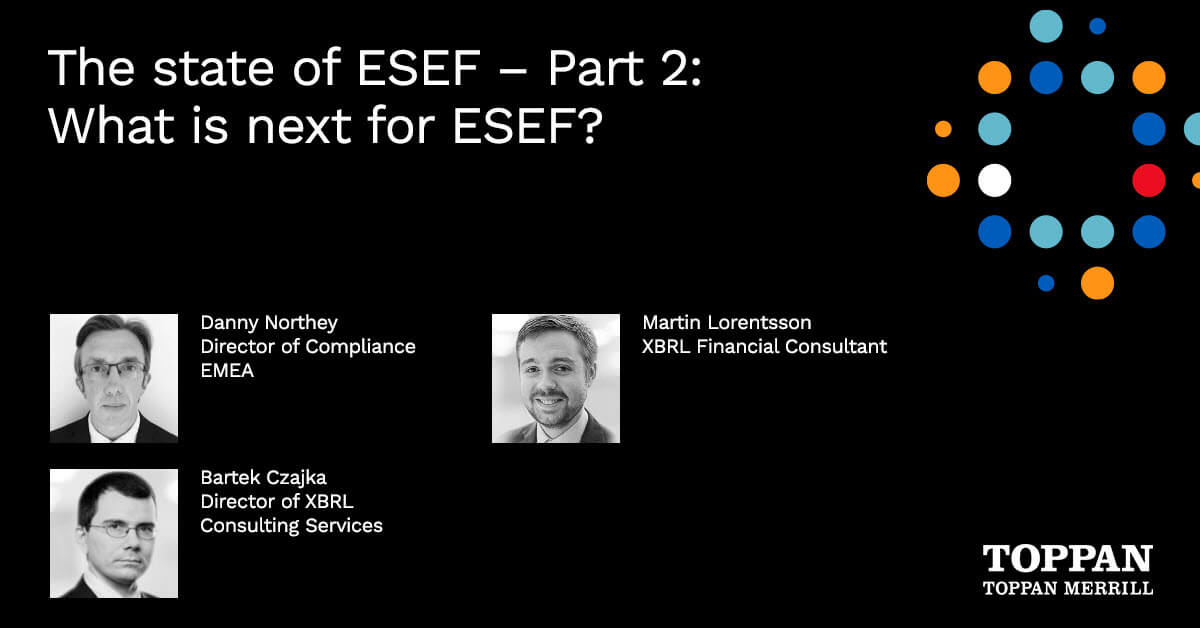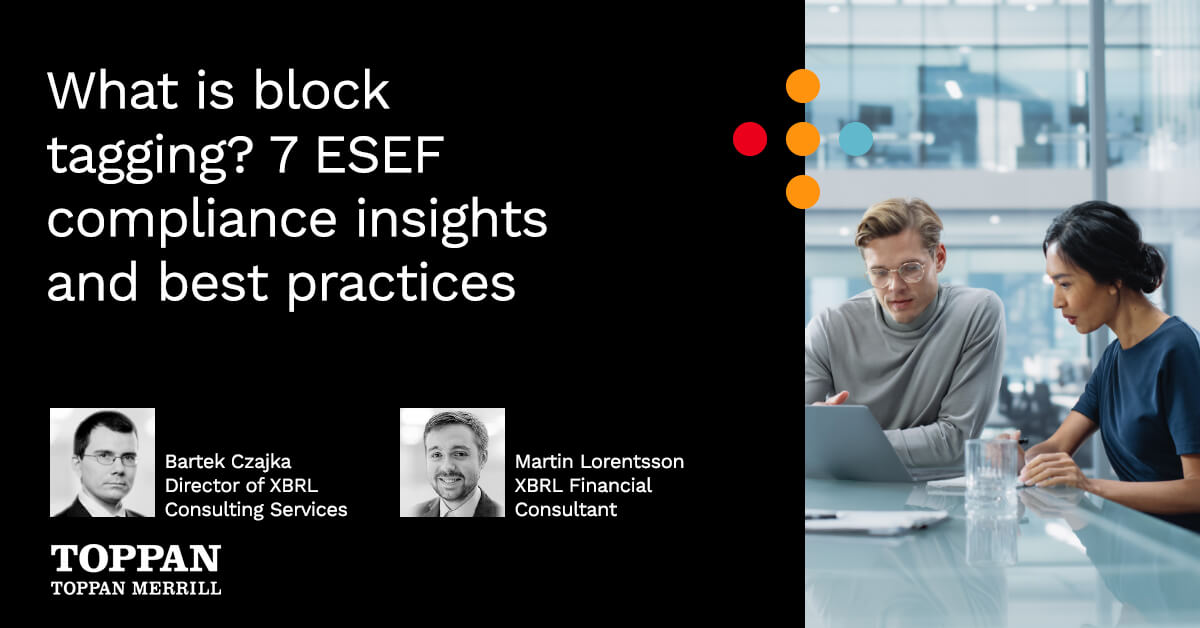Two years into complying with the ESMA ESEF mandate—and looking at year three—we wanted to take stock: how far we have come; what has most surprised clients; how focus is shifting; and where things are headed for the future of ESEF. So, we brought together three of Toppan Merrill’s top experts in all things ESEF for a lively conversation. This is the first in a three-part state of ESEF series.
Meet the ESEF experts

Danny Northey
Director of Compliance, EMEA

Bartek Czajka
Director of XBRL Consulting Services

Martin Lorentsson
XBRL Financial Consultant
Two years into ESEF, where are we at?
Martin Lorentsson: Overall, it’s been a gradual learning curve for everyone. Issuers are figuring out what they need to do. Service providers like us are, in turn, figuring out how best to support issuers. Even auditors have been learning as they go. This gradual progression is what ESMA expected, which is why they chose to phase in the ESEF requirements over time.
Danny Northey: We are seeing clients growing more comfortable with what they need to do at this point. The first year was a bit scary for many issuers. Ultimately, clients had a relatively easy time understanding what they needed to do for tagging of primary financial statements. Adding in block tagging of notes and accounting policies in Year 2 posed more challenges for issuers. Not because the issuers could not do it, but rather because block tagging was a more subjective, time-intensive exercise than many issuers expected.
Now, many issuers are at a point where they are thinking, “Alright, we’ve done it. We’ve complied. We know how to do it. Now, how can we make it better? How can we improve the quality? How can we make the process more efficient, so it’s less work on our end? How can we fit this workflow smoothly into our overall year end reporting process?”
Bartek Czajka: To build on what Martin and Danny said, Year 1 and Year 2 were essentially a compliance exercise. Issuers were focused on understanding and complying with the new mandate. The goal was, “Let’s file it in time; let’s get it done.”
Now that they’ve complied with the full extent of the mandate in Year 2, we’re starting to get more questions on how to make it right. It’s no longer just a compliance exercise. The questions are: Have we filed proper XBRL? Was our quality good?
How have clients’ questions changed?
Lorentsson: The first year, it was new for many issuers. So the focus was on understanding XBRL. Filers had more basic questions around, “What is ESEF? What is an XBRL tag? What does the output look like? And how do I fulfill all the requirements?”
In Year 2, the block tagging requirement shifted the focus dramatically. Clients had fewer questions around review of primary statements, because they had already reviewed most of that in Year 1. So, 80-90% of the time shifted to block tagging. That was not only true for clients’ reviews, but also the auditors’ reviews.
Czajka: “Why?” is the biggest question I’m hearing now. Clients want to understand why a specific tag was chosen, or why an auditor suggested a change. Clients want to know more.
Northey: More clients are starting to think about how much they want to be involved in the process. Clients’ natural inclination is to own the process themselves. But after two years, they’re thinking, “How much time can I spend on this? Do I want to just review it? Or do I want to do everything in the process?”
What was clients’ biggest surprise with block tagging?
Lorentsson: A lot of issuers reported that this year almost felt like a whole new mandate, given the subjectivity of block tagging. Our clients had grown accustomed to the concept of XBRL after going through the tagging of face financials in Year 1, but the tagging of text blocks is very different—to the point that the rules seemed strange to many people. For example, that they have to tag the same thing maybe five or six times—that was counterintuitive.
Northey: Many clients reported that block tagging required a lot more effort than they expected—particularly if it’s audited.
That additional time is extra challenging because, in most companies, it’s not a full team dealing with this; it’s usually just one person. Tagging face financials was relatively simple, but there is more time and responsibility involved in block tagging. In addition, if an issuer is dealing with an auditor, the auditor will have lots of questions, adding more time for the back and forth to resolve those questions.
Lorentsson: The fact that it’s once a year adds a challenge on top of everything that’s already been mentioned. An issuer will go through the whole process, and then not start the process again for perhaps nine months. So, they have to go back and remember everything—what they need to do, and how they do what they need to do.
How are clients’ approaches to ESEF filing changing?
Northey: That one person in charge on the client side is saying, “Wait, hold on a minute. I’m on my own here, and I need to make sure that this is correct,” particularly from a review perspective—and especially if they’re doing the tagging themselves.
Clients want more support—whether from another team member to lighten the load, or an outside party to help them control that process going forward.
Lorentsson: Clients also want more assurance. They’re doing a lot of work on their own, and before they submit it, they want someone they trust to review and say, “Yes, what you’ve done is completely right.”
For example, organisations that worked with other service providers have shared that the biggest thing they felt they were missing was a second set of eyes to make sure what they’re doing was correct—an assurance point.
Northey: In Europe, the audit requirement does add an element of assurance. But the reality is the company may not agree with everything the auditors recommend. Clients are recognising that they need to have an independent review process, as well.
This is even more true on the UK side, since there is no audit requirement. UK issuers definitely want that second pair of eyes—someone with a bit more experience in XBRL, someone to help them understand exactly what the tags mean. They want to bounce their questions and ideas off that person.
Czajka: That speaks to a broader change. After this year’s filings, we are seeing a shift in conversations with filers: The focus is more on quality and accuracy (“How do we get it right?”), whereas in the first two years, as I mentioned earlier, it was more of a compliance exercise (“How do we comply?”).
Why is focus now shifting to XBRL quality?
Czajka: First of all, time was an issue in the first two years. Issuers had new requirements to fit into their already very busy calendars. The main concern was, “Are we going to be able to file our XBRL in time?” With that time constraint, hitting 80% or 90% accuracy was good enough for many issuers.
Lorentsson: Now, filers are starting to understand how their XBRL will be used. They’re recognising that those users of the data (an analyst, an investor, a regulator) might complain if they feel the data is wrong or inaccurate.
Czajka: Another issue is that many service providers positioned XBRL as very simple: It’s just a technical exercise; just a conversion; it’s an easy thing to do.
If an issuer is new to XBRL, and a service provider tells them, “It’s easy. We’re going to do it quickly. You don’t have to worry.” then, they may not worry. The service provider delivered XBRL, they ran the validation, and the validation checked out. The problem is that it’s easy for a service provider to get the XBRL to validate, because it’s more technical validation than content validation. The fact that the report validates does not mean that the tagging is correct accounting-wise. There might be a lot wrong in a report that shows clear XBRL validation.
Now, after the stress of the situation is over and it’s not new and scary, issuers have more time to look a little deeper into quality of their XBRL—to say, “What did we just do, and is it right?”
How is the role of the XBRL service provider changing?
Northey: As mentioned earlier, more issuers recognise that they need (or just want) more support. Not every organisation wants to take on everything, every year. Issuers also want that extra set of eyes to look at their work and assure they’re doing everything right. As issuers think more about quality this year, that expert assurance will only become more valuable to them.
Czajka: Above all, clients want to know more. They want to know that their XBRL is correct; but they also want to understand why tags were chosen, or why auditors suggest changes. They’re not getting those answers from the auditors (which we’ll talk more about in a future post). We’re also hearing from more issuers that are frustrated because their service providers aren’t able to give them those answers, either.
What’s next for ESEF?
With the full ESEF mandate rolled out, there are no new developments for Year 3. Moreover, there is nothing on the ESEF roadmap, either. So, what is next for ESEF? In the second post of our three-part series, our three XBRL experts will share their thoughts—from how auditors continue to evolve their approach, to how regulators will push the focus on XBRL quality, to how the new Corporate Sustainability Reporting Directive (CSRD) will impact ESEF reporting requirements in the coming years.
Keep an eye out for Part 2, coming soon.
Toppan Merrill is here to help
Based across Europe, the dedicated XBRL trained and certified team at Toppan Merrill has worked with numerous companies throughout EMEA to confidently prepare and submit their annual reports. Visit our ESEF Reporting page to learn more – or connect with one of our experts at [email protected] or by calling +44 20.7422.6100.



